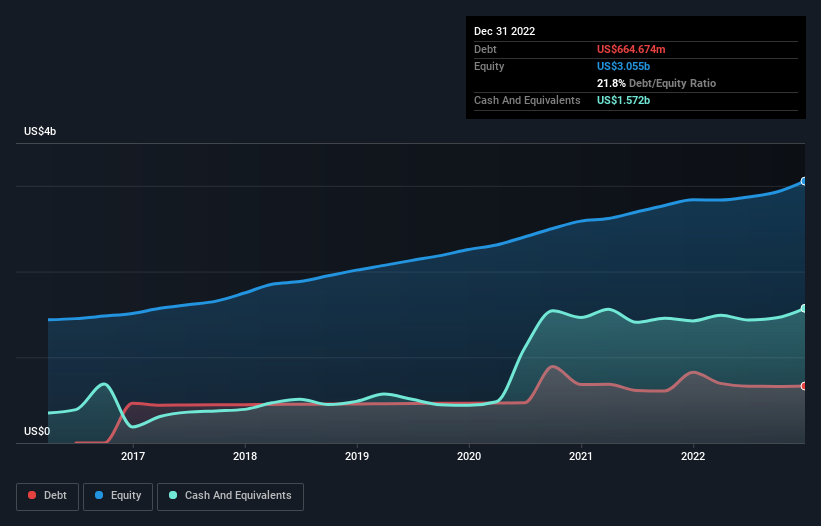
Legendary fund manager Li Lu (who Charlie Munger backed) once said, 'The biggest investment risk is not the volatility of prices, but whether you will suffer a permanent loss of capital.' So it seems the smart money knows that debt - which is usually involved in bankruptcies - is a very important factor, when you assess how risky a company is. We can see that NICE Ltd. (TLV:NICE) does use debt in its business. But the more important question is: how much risk is that debt creating?
Why Does Debt Bring Risk?
Generally speaking, debt only becomes a real problem when a company can't easily pay it off, either by raising capital or with its own cash flow. Ultimately, if the company can't fulfill its legal obligations to repay debt, shareholders could walk away with nothing. However, a more usual (but still expensive) situation is where a company must dilute shareholders at a cheap share price simply to get debt under control. Of course, the upside of debt is that it often represents cheap capital, especially when it replaces dilution in a company with the ability to reinvest at high rates of return. When we think about a company's use of debt, we first look at cash and debt together.
Check out our latest analysis for NICE
How Much Debt Does NICE Carry?
You can click the graphic below for the historical numbers, but it shows that NICE had US$664.7m of debt in December 2022, down from US$825.2m, one year before. However, its balance sheet shows it holds US$1.57b in cash, so it actually has US$906.9m net cash.

A Look At NICE's Liabilities
According to the last reported balance sheet, NICE had liabilities of US$1.14b due within 12 months, and liabilities of US$656.5m due beyond 12 months. Offsetting these obligations, it had cash of US$1.57b as well as receivables valued at US$515.7m due within 12 months. So it actually has US$286.5m more liquid assets than total liabilities.
This short term liquidity is a sign that NICE could probably pay off its debt with ease, as its balance sheet is far from stretched. Simply put, the fact that NICE has more cash than debt is arguably a good indication that it can manage its debt safely.
Another good sign is that NICE has been able to increase its EBIT by 26% in twelve months, making it easier to pay down debt. The balance sheet is clearly the area to focus on when you are analysing debt. But it is future earnings, more than anything, that will determine NICE's ability to maintain a healthy balance sheet going forward. So if you want to see what the professionals think, you might find this free report on analyst profit forecasts to be interesting.
Finally, while the tax-man may adore accounting profits, lenders only accept cold hard cash. NICE may have net cash on the balance sheet, but it is still interesting to look at how well the business converts its earnings before interest and tax (EBIT) to free cash flow, because that will influence both its need for, and its capacity to manage debt. Over the last three years, NICE actually produced more free cash flow than EBIT. There's nothing better than incoming cash when it comes to staying in your lenders' good graces.
Summing Up
While we empathize with investors who find debt concerning, you should keep in mind that NICE has net cash of US$906.9m, as well as more liquid assets than liabilities. The cherry on top was that in converted 143% of that EBIT to free cash flow, bringing in US$398m. So is NICE's debt a risk? It doesn't seem so to us. Above most other metrics, we think its important to track how fast earnings per share is growing, if at all. If you've also come to that realization, you're in luck, because today you can view this interactive graph of NICE's earnings per share history for free.
If you're interested in investing in businesses that can grow profits without the burden of debt, then check out this free list of growing businesses that have net cash on the balance sheet.
Valuation is complex, but we're here to simplify it.
Discover if NICE might be undervalued or overvalued with our detailed analysis, featuring fair value estimates, potential risks, dividends, insider trades, and its financial condition.
Access Free AnalysisHave feedback on this article? Concerned about the content? Get in touch with us directly. Alternatively, email editorial-team (at) simplywallst.com.
This article by Simply Wall St is general in nature. We provide commentary based on historical data and analyst forecasts only using an unbiased methodology and our articles are not intended to be financial advice. It does not constitute a recommendation to buy or sell any stock, and does not take account of your objectives, or your financial situation. We aim to bring you long-term focused analysis driven by fundamental data. Note that our analysis may not factor in the latest price-sensitive company announcements or qualitative material. Simply Wall St has no position in any stocks mentioned.
About TASE:NICE
NICE
Provides cloud platforms for AI-driven digital business solutions worldwide.
Flawless balance sheet with solid track record.
Similar Companies
Market Insights
Community Narratives



